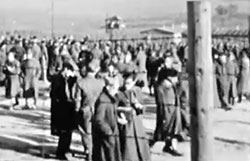Amazing secret film shot with smuggled camera shows life in a World War II POW camp
posted Friday, August 2, 2013 at 2:19 PM EDT

The BBC has just released a 30-minute documentary compiled from astonishing 8mm film footage taken during World War II by a group of French soldiers held in a German prisoner-of-war camp. The prisoners managed not only to smuggle camera parts into the camp and build an 8mm movie camera, but they made a fairly high quality movie of their daily life behind the barbed wire. For good measure, the prisoners also documented their construction of underground escape tunnels.
The BBC documentary illustrates the ingenuity these men used and what has to be described as their "sang-froid" in shooting movies under the apparently not so watchful eyes of their guards. It seems almost like something out of TV's "Hogan’s Heroes" -- except it was real. During WWII, prison escape attempts were frequent and often deadly, but occasionally successful. The French photographer Henri Cartier-Bresson, for instance, escaped twice from German prison camps
The film was made by the prisoners of Oflag 17a with a camera smuggled into them from the outside. They had discovered that their German guards would check sausages and other food stuffs sent to the prisoners by cutting them in half. Using this tidbit of information, the prisoners had parts sent to them concealed in sausages’ ends. Voilà! While it sounds incredible, a whole 8mm camera and many reels of unexposed film made its way into the camp this way, sort of a Bolex in a pig.
Once the camera was assembled (and de-porked), the prisoners shot the film as the French say, "Sous Le Manteau" -- or under the overcoat -- and it's the name the BBC gives this documentary. Hidden in a carved out dictionary from the camp library, and using the book spine as the shutter release, the prisoners went around the camp making this extraordinary film. Surprisingly the guards seemed not to have questioned why this particular dictionary was so popular.
You can see an excerpt of the video below or in a better restored version on the BBC's website.
Lieutenant Jean Cuene-Grandidier was one of the 5,000 prisoners in Oflag 17a (an Oflag in Austria, a Stalag in Poland) and last month celebrated his 100th birthday. He was a member of the escape committee and was given the Legion of Honor medal at a recent celebration in Paris honoring the French prisoners-of-war.
Despite what seems to us to be amazing bravery, Cuene-Grandidier is somewhat blasé in his description of the prisoners' efforts.
"In the early days we tried digging a number of tunnels from the huts in which we were barracked, it was viewed as a form of resistance," Cuene-Grandidier told the BBC. "We were never punished. The Germans seemed to accept it, though it never worked. The distances to the wire were too great. And in any case the guards were clever. They always found the tunnels we started. They were looking for the earth we'd removed."
Sound familiar? Do you remember the scene in the movie "The Great Escape" where Steve McQueen and others walk around the prison yard, disposing the dirt they had packed into their pants after their tunnel digs?
The BBC documentary gives us a remarkable glimpse of life in the camp with its frequent food shortages and random searches by the guards. However, there was no forced labor and prisoners were "free" to spend their days more or less as they wished. They even built a theater and put on shows, something which -- it turns out -- was common in POW camps across Europe.
In the film, we see the prisoners making boots with false heels in which the 8mm reels were later hidden. We get to watch the escape committee at work as they dig one of the 32 escape tunnels they built under the camp and under the very feet of their guards. The film’s grainy, black-and-white images create a surreal atmosphere in which prisoners spend their time almost casually working on their escape, all the while documenting their efforts.
On Sept. 17, 1943, the escape plan was put into action. On the first night, a large group of prisoners broke free and their disappearance went unnoticed because the Germans had canceled weekend roll-call. The following night another group ran off. In the ensuing days, most of the prisoners were recaptured -- but not Jean Cuene-Grandidier. He made it back to Paris and his return journey is another tale of courage and luck in itself. Once home, Jean’s war didn’t end: Within a short time he was back fighting the Germans as part of the Resistance.